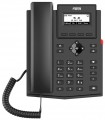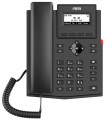Connection interfaces provided in the design of the phone.
—
WAN. Connector for wired connection to global computer networks. The best example of such a network is the Internet, but there are other networks, usually, specialized ones. In IP phones, the WAN port is most often used specifically for connecting to the Internet directly, without the use of routers and other equipment. However, this interface usually uses a standard RJ-45 network port — the same as in the Ethernet interface (see below); however, it is not suitable for working with local networks — WAN and LAN use different communication protocols.
—
Ethernet. Wired interface used to connect to local area networks (LANs); colloquially, it is often referred to as “LAN”, it uses a standard RJ-45 connector. Note that in this case, not all types of Ethernet are meant, but only the “classic” version of Fast Ethernet, which supports speeds up to 100 Mbps. It is slower than the Gigabit Ethernet described below, but in most cases this speed is more than enough.
—
Gigabit Ethernet. A type of Ethernet connector, characterized by an increased data transfer rate — up to 1 Gbps (hence the name). On the one hand, this connector is considered more advanced. On the other hand, the real need for such speeds arises quite rarely, mainly when transferring large amounts of data (for example, during vi
...deo communication). And not all network equipment supports Gigabit Ethernet. Therefore, this interface is relatively rare in IP phones.
— USB. Universal port used to connect external peripherals. In IP phones, this port can be used for Bluetooth adapters, some headsets, external cameras, USB drives (for various purposes), and in the most advanced models, even for keyboards and mice. And some devices with this interface are themselves designed for use as peripherals — these are separate wired models (for more details, see "Type").
— HDMI. Versatile digital video and audio output for high-definition video and audio up to multi-channel. It is relevant primarily for working with video telephony: you can connect a large external screen (monitor, TV or even a wall panel) to the HDMI connector and communicate using this screen, which is much more convenient than using a small built-in phone display. At the same time, the presence of at least one HDMI input is actually mandatory for modern video devices, which provides very extensive possibilities for their connection.
— Card reader. A slot for working with memory cards (most often SD or microSD). In different models, the ways of using such slots may also be different. So, one of the most popular options is to record conversations on a memory card, however, other possibilities may be provided — from purely service ones, such as updating the firmware and loading automatic settings, to playing video files on the phone's own screen and working with Android OS applications (see "Features"). Anyway, the presence of a card reader provides additional features, including exchanging data with other devices. Also note that removable cards are the most convenient way to expand the built-in storage of the device (see below) — in terms of gigabytes of volume, they are much cheaper than built-in drives, and you can choose the size of the card at your discretion.
— WiFi. A wireless interface used to build computer networks, access the Internet through such networks or wireless access points, and more recently, direct connections between various devices. The main advantage of this interface over Ethernet is the absence of wires, which facilitates the installation and movement of stationary equipment, and also allows you to create portable wireless IP phones that work like mobile phones (for more details, see "Type"). Among the shortcomings, it is worth noting a slightly lower reliability and practical communication speed. And a direct WiFi connection can be used, for example, to connect with a smartphone to synchronize contacts and call logs.
— Bluetooth. A wireless technology designed to connect devices directly to one another. The possibilities of such communication in different models of IP phones may be different — it all depends on the set of Bluetooth protocols provided by the manufacturer. The most popular options are connecting wireless headsets and direct data exchange with a smartphone, tablet, etc. (file transfer, contacts synchronization, etc.). The Bluetooth range is about 10m.
— Jack for the headset. A port for connecting a wired headset; it can be either a standard socket like a 3.5 mm mini-jack or a proprietary port. Anyway, wired headsets allow the speaker to keep their hands free — for example, for taking notes — without turning on the speakerphone and without resorting to other tricks like holding the handset with their shoulder. However wired headsets are not as convenient as wireless ones with Bluetooth connection (see above); on the other hand, they have unlimited run time and are cheaper.
